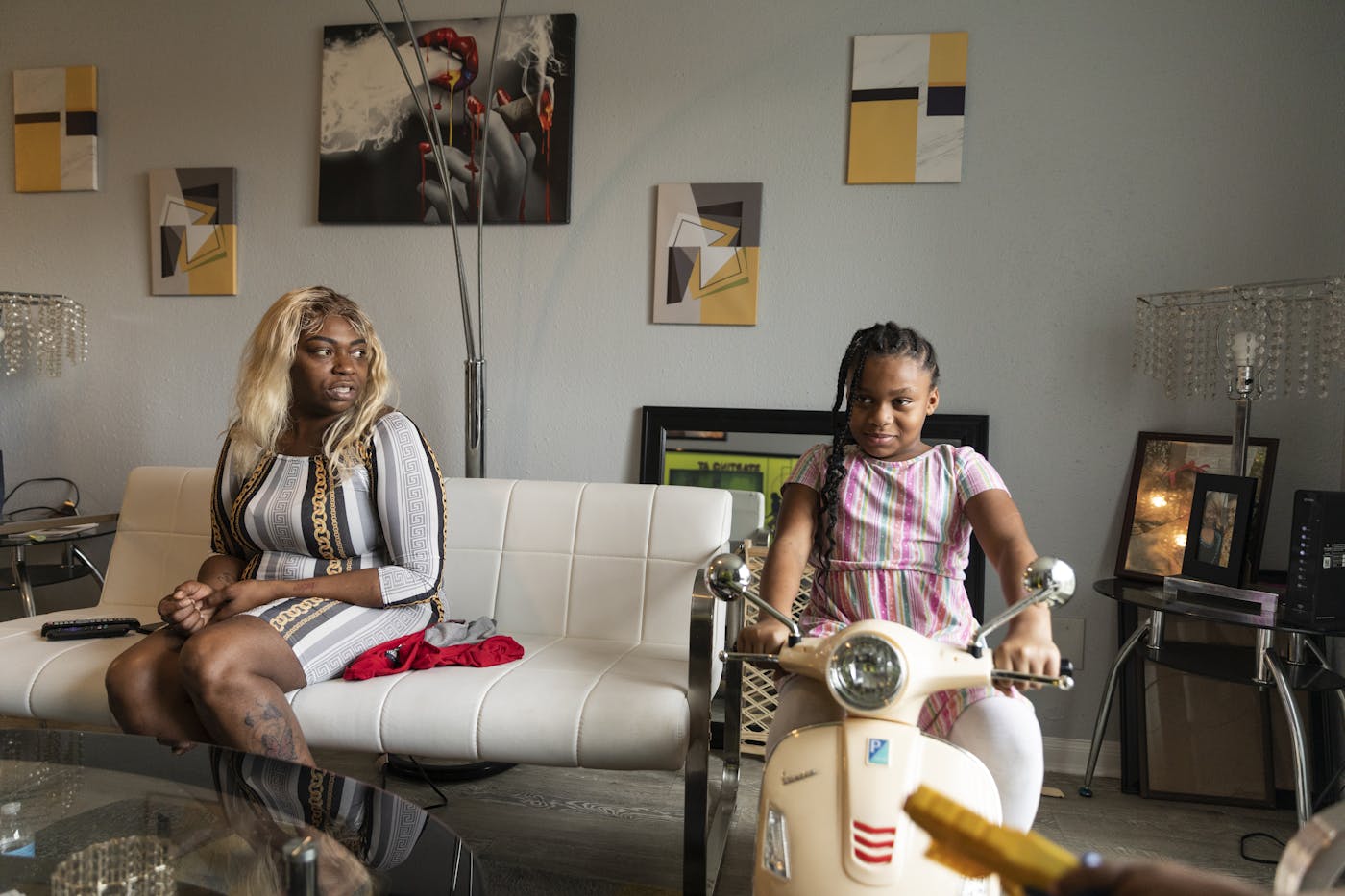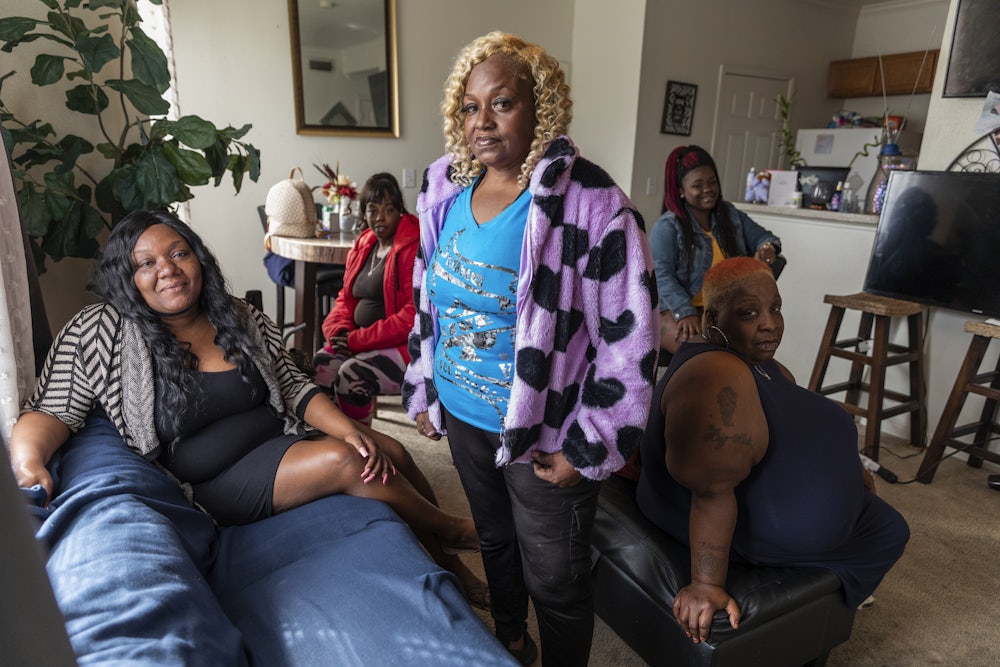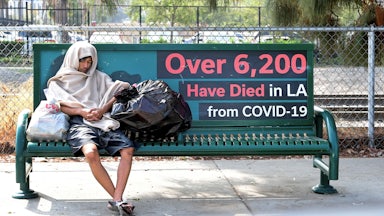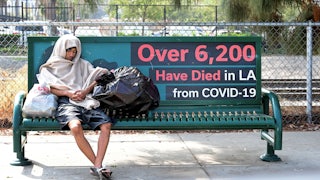Before the sun was up one misty morning in mid-January, Joshlyn Caldwell, age 51, roused the five unhoused people she let sleep in her north Houston apartment—a man, a woman, and a young family of three. The men helped Joshlyn, who has been disabled since a 2010 car accident, limp down the stairs from the second story, and everyone piled into her dark gray SUV, arriving a little before 9 a.m. at the Beacon, a nonprofit downtown that connects people to homeless service providers across the city. The line in the courtyard outside the housing office was around nine people long, with one person receiving service inside. This made Joshlyn nervous. Next to the office door, a sign stated the housing department sees the first 20 to 30 people for assessment, depending on the number of available assessors each day. But sometimes it’s less, she told me. “It depends on how they feel.”
The Beacon’s wide, red-brick building is enclosed by an iron fence and sits adjacent to a Episcopal church and the old Houston cotton exchange.** Every morning, men in neon-green shirts pick trash off the Beacon’s sidewalks, stepping over people camping there, occasionally asking if an item belongs to someone before tossing it. Joshlyn has spent many mornings here advocating for unhoused people lost in the housing application process, not as an official caseworker—in fact, she was homeless herself until 2016, when the Beacon connected her with housing. But when service providers go AWOL, she’s often the one wrangling the documents necessary to land an apartment.
After the group had been at the Beacon for 20 minutes, Josh Davis, a housing assessor, stepped into the courtyard outside the housing office with a clipboard, and the line of people converged around him, including Joshlyn and her five clients. There was Raymund Hollins, 46, who said he had lived in his car for a year before Joshlyn found him; Desiree Hill, 50, who called Joshlyn immediately after being released from the psychiatric hospital; and Passion Clark, 19, with her boyfriend, Jaseven Hill, and their 2-year-old, Mackenzie, fast asleep in a pink jumper. Everyone leaned in with palpable urgency, waiting in silence for their turn to ask about their case.
“Right now, we can’t take new applicants,” he said. “Our system is backed up.”
In recent years, Houston has been trumpeted as the gold standard for its brand of “housing first” homeless services. Supported by the U.S. Department of Housing and Urban Development, this program and others like it race to house people before pairing them with necessary treatments. This has been a complete shift for the city over the past decade. In 2011, HUD dinged Houston as a “priority community” after homelessness increased by 25 percent in one year.
What changed? In 2012, a messy web of nonprofits partnered with Harris County, where Houston is located, to centralize their data and leadership under a nonprofit known as the Coalition for the Homeless, or CFTH, which works with over 100 other local nonprofits to expedite the process of matching unhoused people with open apartments owned by partner landlords. Funded with $42 million annually from HUD, these nonprofits create a safety net that is simultaneously outside of and akin to the local government. For better or worse, Houston housing providers have to follow regulations for how they can use their funding and who gets access to resources. Aside from small tweaks in HUD’s language, these regulations have remained largely the same over the past decade. While other U.S. cities, under the same funding restrictions, implemented a patchwork approach and fell victim to poor planning or scant resources, Houston wagered that centralized decision-making could speed up the process.
If you believe the remarkable statistics, it was the correct gamble. Today, CFTH boasts a 54 percent decrease in homelessness over the past 10 years as of 2021 (from over 8,500 to 3,055 people), and representatives from across the country—and even London, according to Houston Mayor Sylvester Turner’s office —have made the pilgrimage to the city to study how it did it. On January 26, the mayor doubled down on the approach, announcing a $100 million increase in funds for the Communitywide Covid-19 Housing Program, or CCHP, on top of the original $65 million charter that housed more than 7,000 people from October 2020 to December 2021.
But if you talk to people who are unhoused in Houston, or are working to help people find stable housing, the picture is far less rosy. The problem is that homelessness is a more expansive issue than a single statistic can reveal. Many who struggle to find a place to sleep each night don’t qualify for HUD’s official definition of what makes someone unhoused—and in Houston, even if you do, the public-private nature of the program can place people in inadequate homes with apathetic landlords. Homelessness has steadily increased nationwide since 2016, and though the numbers are different in Houston, the pandemic helped expose the preexisting fissures in the city’s system, leaving some of the most vulnerable in isolated situations far from the assistance they need.
Houston historically has had one of the highest number of evictions of the cities tracked by Eviction Lab, and rental assistance programs during the pandemic merely slowed the rising tide.* The same year CFTH housed more than 7,000 people, Houston’s annual homeless count only dropped from 3,829 to 3,055. The fact that people are being placed in temporary housing at a faster rate than the decline of people living on the street indicates Houston’s investments do work to a degree. But due to HUD’s stunted categorization of homelessness, which drastically limits who qualifies for certain services, along with harsh policing and shaky agreements with landlords, the U.S. brand of housing first kicks some people out before they can open the door.
It’s helpful to think of housing insecurity as a ladder, James Gonzalez, program operations director for CFTH, told me. You have those who live perpetually off-balance, perhaps stepping up one or two rungs before falling back to the ground, and then you have those who, due to a confluence of factors, cannot seem to climb at all. Before anyone else, he said, CFTH has to help those stuck at the bottom. “In our kind of HUD-world, we have to go with who’s in the most crisis. Then, when there are funds available, we can move up that ladder.”
HUD restricts housing services to two main categories. To be deemed “literally homeless,” thus qualifying for a spot in Houston’s one-year rapid rehousing program, you must live outside or sleep in a shelter. Three of the five people living with Joshlyn are not “literally homeless.” To qualify for permanent housing, one must be “chronically homeless,” meaning as well as living outside for at least 12 months, you must also have a physical or mental disability. (Raymund, Desiree, and Joshlyn fall into this category.) Once unhoused people have been placed in an apartment, CFTH boasts a 90 percent success rate for transitioning them to enduring housing—85 percent for the “literally homeless,” 95 percent for the “chronically homeless”—but this has become a more difficult task in recent years. “It used to be the rental market was fine and we didn’t have enough [housing] programs,” Gonzalez said. “Now we have an abundance of programs and we’re having to figure out how to make units available.”
Once a year, when HUD asks municipalities to count unhoused people for that specific point in time, they use these strict categories to determine who qualifies as homeless, skewing the national understanding of the crisis. It creates an artificially low denominator that makes it easier to show a drop in homelessness even if material living conditions haven’t changed. What if someone sleeps on their friend’s couch for a couple days or has the money to book a motel room? What if they sleep in their car, out of public view? Even if a fraction of the people who received housing through the Beacon were not homeless, which would be a violation of HUD’s guidelines, it’s possible, in the city with fewer affordable housing units per extremely low-income families than almost anywhere else in the U.S., that they were about to be.
“Our biggest limitation is simply our geographic area,” said Catherine Troisi, an epidemiologist at the University of Texas School of Public Health who annually certifies Houston’s data collected by CFTH. This year, 469 Houston volunteers combed through more than 3,500 square miles of roads, parks, and alleys, from January 25 to 27. HUD instructs volunteers to avoid crossing busy highways, entering dark parks, alleys, and abandoned buildings due to safety concerns. But “where do they think people experiencing homelessness are going to be?” said Eric Tars, legal director of the National Homelessness Law Center, particularly when Houston’s camping and panhandling bans are enforced and unhoused people are incentivized to stay out of public view. To Tars, relying on these categorizations to determine policy “harms our ability to mobilize resources that are necessary to actually end” homelessness.
“A lot of unsheltered people don’t necessarily live on the streets,” said Chicago Jackson of the Houseless Organizing Coalition, or HOC, a local union of housed and unhoused people unaffiliated with Houston’s conglomerate of nonprofits involved in CFTH’s housing program. To Jackson, the answer is to provide housing without all the restrictions. HOC’s goal is to give unhoused people the necessary support and political education to demand more than what they’re given, because often people settle, out of fear of landing back on the street. “I think it’s disrespectful,” Jackson told me, “all this money they claim to be putting toward housing people. They’ll take away your housing for the simplest things.”
Houston gets special permission from HUD to conduct the count over the course of three days, rather than the standard single night, and acknowledges in its yearly reports that the data is not all-encompassing. Still, it’s the number it uses to say it has seen a 54 percent reduction in homelessness. Troisi said while the data may not be wholly accurate, “when every year we see a decrease” it shows something is working. But Troisi has elsewhere noted, in a 2017 “expanded” count, that if you include individuals in county jails who report that they are unhoused, the total number increased by 57 percent for that year—from around 3,600 to over 5,600 people experiencing homelessness.
The problems people face also don’t necessarily end when they technically have a place to sleep. Due to Joshlyn’s physical disability, her cardiologist advised her to avoid strenuous activity and move to a ground-level apartment. She’s asked to be moved three times over the course of three years, referring her case manager to her doctor’s note. She’s been placed in a second-story apartment each time. Last year, she signed a lease expecting the first-story apartment, but when she arrived on site the home was already taken.
HUD’s reasonable accommodations allow for tenants to transfer to a ground-floor unit but not for landlords to make a ground-floor unit available. Still, in Joshlyn’s case, her property manager gave away her reserved first-floor apartment before she could move in. “A lot of people are grateful,” Joshlyn said, “but a lot settle because we don’t have choices.”
At the Beacon that morning, Desiree asked the assessor, Davis, if he could check for her under a different name; Passion and Jaseven each implored him to check up on their case; and Raymund, who had visited the Beacon with Joshlyn six times because his paperwork had been filled out wrong, was redirected to the Beacon’s clinic to certify his medical file. There was another person on Joshlyn’s mind who couldn’t make it: Quintella Caldwell, her oldest daughter.
Joshlyn was only 15 when she gave birth to Quintella in 1985. Her family agreed she wasn’t ready to be a mother, so Quintella’s great-aunt adopted her. At around the same time, Joshlyn said, someone handed her a cigar laced with crack, and the following decades were a blur. “I really didn’t raise my kids,” Joshlyn told me. “We have a better relationship because I didn’t raise them.” In 2014 she found God, got clean, and has held odd jobs on and off that were understanding of her disability. Now she knows how to navigate the housing system and can finally give her kids something.
But on her own, Joshlyn can only do so much. To untangle the knots left by generations of housing insecurity, the only lasting solutions are systemic.
Quintella “Quan” Caldwell was watching the cars race down the wide road outside her front door, taking deep breaths of her cigarette. Her rapid rehousing voucher was accepted at a complex on Houston’s east side, near Jacinto City, 15 minutes by car from downtown. In Houston, it’s common for those in rapid rehousing to take the bus far from home to visit one of the food pantries consolidated downtown. A UT Health map pinpoints Quintella’s apartment in a food desert. She might have mold—one wall started to blacken at around the same time the toilet stopped working. Still, with the toys of her two children, Faith, age 9, and Zi’Aire, 4, strewn across the floor, it looks like home, and her job at Taco Bell paid for groceries—that is, until Faith caught Covid-19 and Quintella had to stay home to take care of her, which led to her losing her job. It should be enough. “I try to be grateful,” she said, referring to her apartment. “But the downside is the rats.”
A report filed with the city of Houston identifies the rodents as mice, but it makes little difference to Quintella. Either way, they ate through her pantry enough times that she stopped buying more than a day’s worth of food at a time. She also had to throw away many of her kids’ clothes, including Faith’s favorite blankets, after finding holes and droppings in their hamper.

The main conceit of HUD’s housing-first initiative modeled by Houston was to shelter people quickly before providing supportive services, laying a stable foundation on which each person could grow. But these programs also jury-rig nonprofits and landlords to function as an arm of the state, reducing the burden on local taxpayers to a degree, but also thrusting some unhoused people from one difficult living situation to another, depending on their landlord.
“Across Houston, there are so many apartment complexes that are not run well,” one caseworker, who asked to remain anonymous, told me, and tenants must often complain to the city before anything is done. Quintella contacted the city in October about the infestation. In November, she received a notification that the problem was resolved. Only it wasn’t. She sent me a picture of another dead mouse in her bathroom on January 31.
“Just because you have four walls and a roof over your head does not mean you’re adequately housed and does not mean HUD has done its job of housing somebody,” said Tars. If you give someone a place like that, Joshlyn said, “you’re going to make them feel more homeless.”
One person I spoke to went without furniture, including a mattress, for weeks, sleeping on the floor with a pair of white sheets from his caseworker. Another said her caseworker disappeared for months after new management purchased her apartment complex and stated they would no longer accept her voucher at the end of her lease. Chicago Jackson told me property management switches are the most common way she’s seen people lose housing, and that often unhoused people feel it’s an ultimatum: Move into a cheaper apartment, often in worse condition, or lose your home again. Gonzalez told me there have been incidences in the past of infestations but that CFTH moves quickly to resolve such issues.
Quintella’s voucher was supposed to be good for one year. But in October she received an eviction notice with a bill demanding over $7,500 in back-rent. She tried going to her landlord, but it turned into a bureaucratic nightmare—speaking first with her caseworker, who was supposed to contact CFTH’s landlord engagement team, which was supposed to contact the landlord, and so on. “I know it does seem like telephone, but we want to make sure that we’re giving the landlord the opportunity to correct the situation,” said Ashlie Young, CFTH’s manager of landlord engagement, adding that there are stringent livability standards applied to all landlords partnered with the program.
In the meantime, Quintella lived in fear of losing her home for months. Finally, on December 6, she received a text from her case manager with screenshots verifying that the bills had been paid. Quintella may still end up one of the 85 percent who successfully transition out of homelessness, but that decision isn’t entirely up to her.
Like a family heirloom, housing insecurity is often passed down from one generation to another. In private moments, when it’s safe to cry without her children seeing, Quintella prays that she can provide them with more than her mother did for her and help them reach higher on the ladder than she could herself, and that their housing now will lead them there. Given their history, she’s still sometimes wary of her mother, but “my kids make me appreciate her,” she told me. Four-year-old Zi’Aire FaceTimes Joshlyn all the time, and in public Faith, who often puts on a brave face, still hides behind Joshlyn’s sleeve. This Christmas, Joshlyn gave Quintella’s kids a puppy named Spot. He’s only half a gift for the kids—he also scares away the mice.
“My kids don’t really love me. Like, you know, love me,” Joshlyn told me. “But that’s OK,” she said, and she hopes to earn their trust one day. Joshlyn has been clean and housed for more than five years, more stable than she’s ever been, but she can never leave her years of homelessness behind. They haunt her even now. “I thank God I went through it, because I learned a lot,” she told me. “But I never want to go through it again.”
* This article originally mischaracterized Houston’s eviction numbers.
** This article originally misidentified an Episcopal church as Catholic and incorrectly identified the tenants at the Houston cotton exchange.
This story was supported by the journalism nonprofit the Economic Hardship Reporting Project.






